Seismic Damage Investigation of Spatial Frames with Steel Beams Connected to L-Shaped Concrete-Filled Steel Tubular (CFST) Columns
Abstract
:1. Introduction
2. Finite Element Models
2.1. General Description
2.2. Material Constitutive Equations
2.2.1. Material Modeling of Steel
2.2.2. Material Modeling of Core Concrete
2.3. Finite Element Type and Mesh
2.3.1. Finite Element Type
2.3.2. Finite Element Mesh
2.3.3. Interface and Contact Processing
2.3.4. Boundary Conditions and Load Application
3. Frame Tests
3.1. Design of Experimental Specimens
3.2. Test Setup and Loading System
3.3. Test Results and Discussion
3.3.1. Failure Modes
3.3.2. Lateral Load (P) versus Lateral Displacement (∆)
4. Verification of the Finite Element Model
5. The Stress Analysis of the Composite Frame—A Further Numerical Study
6. Conclusions
- (1).
- the experimental results showed that the steel beam connected to L-shaped concrete-filled steel tubular column spatial frames had high earthquake resistance capacity. The failure modes of this composite frame followed the principle of the strong-column-weak-beam and strong-joints;
- (2).
- the FEA model developed in this paper was able to simulate the behavior of L-shaped concrete-filled steel tubular column spatial frames that were subjected to combined constant axial load and cyclic lateral loading accurately;
- (3).
- an effective stress-strain constitutive model was proposed in this paper, which described the behavior of confined concrete in L-shaped steel tube accurately. The interface and contact model introduced in the model improved the performance of the model in simulating the real behavior of the specimen; and,
- (4).
- cased on the results of the nonlinear analysis, the stress developing progress of L-shaped CFST columns was investigated. The load transferring mechanism and failure mechanism can be determined effectively.
Author Contributions
Funding
Acknowledgments
Conflicts of Interest
References
- Han, L.H.; Li, W.; Yang, Y.F. Seismic behaviour of concrete-filled steel tubular frame to RC shear wall high-rise mixed structures. J. Constr. Steel Res. 2009, 65, 1249–1260. [Google Scholar] [CrossRef]
- Chen, J.; Wang, Z.; Yuan, J. Research on the stiffness of concrete filled tubular column and steel beam joint with stiffening ring. J. Build. Struct. 2004, 4, 006. (In Chinese) [Google Scholar]
- Yu, Q.; Tao, Z.; Wu, Y.X. Experimental behaviour of high performance concrete-filled steel tubular columns. Thin-Walled Struct. 2008, 46, 362–370. [Google Scholar] [CrossRef]
- Han, L.H.; Li, W.; Bjorhovde, R. Developments and advanced applications of concrete-filled steel tubular (CFST) structures: Members. J. Constr. Steel Res. 2014, 100, 211–228. [Google Scholar] [CrossRef]
- Sakino, K.; Nakahara, H.; Morino, S.; Nishiyama, I. Behavior of centrally loaded concrete-filled steel-tube short columns. J. Struct. Eng. 2004, 130, 180–188. [Google Scholar] [CrossRef]
- Giakoumelis, G.; Lam, D. Axial capacity of circular concrete-filled tube columns. J. Constr. Steel Res. 2004, 60, 1049–1068. [Google Scholar] [CrossRef] [Green Version]
- Ge, H.; Usami, T. Strength of concrete-filled thin-walled steel box columns: Experiment. J. Struct. Eng. 1992, 118, 3036–3054. [Google Scholar] [CrossRef]
- Roeder, C.W.; Lehman, D.E.; Bishop, E. Strength and stiffness of circular concrete-filled tubes. J. Struct. Eng. 2010, 136, 1545–1553. [Google Scholar] [CrossRef]
- Wang, Z.B.; Tao, Z.; Han, L.H.; Uy, B.; Lam, D.; Kang, W.H. Strength, stiffness and ductility of concrete-filled steel columns under axial compression. Eng. Struct. 2017, 135, 209–221. [Google Scholar] [CrossRef] [Green Version]
- Wu, L.Y.; Chung, L.L.; Tsai, S.F.; Shen, T.J.; Huang, G.L. Seismic behavior of bolted beam-to-column connections for concrete filled steel tube. J. Constr. Steel Res. 2005, 61, 1387–1410. [Google Scholar] [CrossRef]
- Ding, F.X.; Yin, G.A.; Wang, L.P.; Hu, D.; Chen, G.Q. Seismic performance of a non-through-core concrete between concrete-filled steel tubular columns and reinforced concrete beams. Thin-Walled Struct. 2017, 110, 14–26. [Google Scholar] [CrossRef]
- Zhong, S. Concrete-Filled Steel Tubular Structure, 3rd ed.; Tsinghua University Press: Beijing, China, 2003. (In Chinese) [Google Scholar]
- Guo, L.H.; Wang, Y.Y.; Zhang, S.M. Experimental study of concrete-filled rectangular HSS columns subjected to biaxial bending. Adv. Struct. Eng. 2012, 15, 1329–1344. [Google Scholar] [CrossRef]
- Liu, J.; Yang, Y.; Liu, J.; Zhou, X. Experimental investigation of special-shaped concrete-filled steel tubular column to steel beam connections under cyclic loading. Eng. Struct. 2017, 151, 68–84. [Google Scholar] [CrossRef]
- Yang, Y.; Yang, H.; Zhang, S. Compressive behavior of T-shaped concrete filled steel tubular columns. Int. J. Steel Struct. 2010, 10, 419–430. [Google Scholar] [CrossRef]
- Shen, Z.Y.; Lei, M.; Li, Y.Q.; Lin, Z.Y.; Luo, J.H. Experimental study on seismic behavior of concrete-filled L-shaped steel tube columns. Adv. Struct. Eng. 2013, 16, 1235–1247. [Google Scholar] [CrossRef]
- Chen, Z.H.; Zhou, T.; Wang, X.D. Application of special shaped column composed of concrete-filled steel tubes. In Advanced Materials Research; Trans Tech Publications: Zürich, Switzerland, 2011; Volume 163, pp. 196–199. [Google Scholar]
- Chen, Z.Y.; Shen, Z.Y. Behavior of L-shaped concrete-filled steel stub columns under axial loading: Experiment. Adv. Steel Constr. 2010, 6, 688–697. [Google Scholar]
- Gang, C.J.S. Experimental investigation on L-shaped concrete-filled steel tube stub columns with binding bars under axial load. China Civ. Eng. J. 2008, 9, 4. (In Chinese) [Google Scholar]
- ZHI, C.; Bin, R.; Fafitis, A. Axial Compression Stability of a Crisscross Section Column Composed of Concrete-Filled Square Steel Tubes; Mathematical Sciences Publishers: Berkeley, CA, USA, 2009; p. 1787. [Google Scholar]
- Zhou, T.; Chen, Z.; Liu, H. Seismic behavior of special shaped column composed of concrete filled steel tubes. J. Constr. Steel Res. 2012, 75, 131–141. [Google Scholar] [CrossRef]
- Patel, V.I.; Liang, Q.Q.; Hadi, M.N.S. Numerical analysis of high-strength concrete-filled steel tubular slender beam-columns under cyclic loading. J. Constr. Steel Res. 2012, 92, 183–194. [Google Scholar] [CrossRef]
- Patel, V.I.; Liang, Q.Q.; Hadi, M.N.S. Inelastic stability analysis of high strength rectangular concrete-filled steel tubular slender beam-columns. Interact. Multiscale Mech. 2012, 5, 91–104. [Google Scholar] [CrossRef] [Green Version]
- Patel, V.I.; Liang, Q.Q.; Hadi, M.N. Nonlinear inelastic behavior of circular concrete-filled steel tubular slender beam-columns with preload effects. In Proceedings of the 10th International Conference on Advances in Steel Concrete Composite and Hybrid Structures, Singapore, 2–4 July 2012. [Google Scholar]
- Herrera, R.; Ricles, J.M.; Sause, R.; Lewis, B. Seismic Performance Evaluation of Steel Moment Resisting Frames With Concrete Filled Tube Columns. In Proceedings of the International Workshop on Steel and Concrete Composite Construction (IWSCCC-2003), Taipei, Taiwan, 8–9 October 2003; pp. 143–152. [Google Scholar]
- Dasgupta, P.; Goel, S.C.; Parra-Montesinos, G.; Tsai, T.C. Performance-based seismic design and behavior of a composite buckling restrained braced frame. In Proceedings of the 13th World Conference on Earthquake Engineering, Vancouver, BC, Canada, 1–6 August 2004; pp. 1–6. [Google Scholar]
- Liu, W.; Li, J. Pseudostatic test on the RC frame with special-shaped columns. Struct. Eng. 2002, 3, 56–61. (In Chinese) [Google Scholar]
- Han, L.H.; Wang, W.D.; Tao, Z. Performance of circular CFST column to steel beam frames under lateral cyclic loading. J. Constr. Steel Res. 2011, 67, 876–890. [Google Scholar] [CrossRef]
- Li, B.; Xue, G.; Zhang, Y. Experimental study on seismic behavior of concrete-filled steel tubular frame. Earthq. Eng. Eng. Vib. 2002, 22, 53–56. (In Chinese) [Google Scholar]
- Wang, W.D.; Han, L.H.; Zhao, X.L. Analytical behavior of frames with steel beams to concrete-filled steel tubular column. J. Constr. Steel Res. 2009, 65, 497–508. [Google Scholar] [CrossRef]
- Wang, T.C.; Lu, M.Q.; Zhang, H.B. Analysis of the effect of slenderness ratio on the ductility of CFRT frames. J. Harbin Inst. Technol. 2005, 3, 14. [Google Scholar]
- Hu, J.W.; Kang, Y.S.; Choi, D.H.; Park, T. Seismic design, performance, and behavior of composite-moment frames with steel beam-to-concrete filled tube column connections. Int. J. Steel Struct. 2010, 10, 177–191. [Google Scholar] [CrossRef]
- Park, T.; Hwang, W.S.; Leon, R.T.; Hu, J.W. Damage evaluation of composite-special moment frames with concrete-filled tube columns under strong seismic loads. KSCE J. Civ. Eng. 2011, 15, 1381–1394. [Google Scholar] [CrossRef]
- Wang, X.; Hao, J.; Zhou, G.; Zhang, Y.; Ma, Y. Experimental research on seismic behavior of two-story two-bay concrete-filled square steel tubucolumns frame. Earthq. Eng. Eng. Vib. 2010, 30, 70–76. [Google Scholar]
- Wang, X.; Ma, Y.; Wang, L.; Hao, J.; Luo, G. Experimental study and nonlinear finite element analysis of seismic behavior of concrete-filled square steel tubular frame. Earthq. Eng. Eng. Vib. 2013, 33, 126–133. [Google Scholar]
- Zhou, T.; Jia, Y.; Xu, M.; Wang, X.; Chen, Z. Experimental study on the seismic performance of L-shaped column composed of concrete-filled steel tubes frame structures. J. Constr. Steel Res. 2015, 114, 77–88. [Google Scholar] [CrossRef]
- Xu, C. Experimental and Theoretical Research on Seismic Behavior of Concrete-Filled Steel Tubular Frames. Ph.D. Thesis, Tianjin University, Tianjin, China, 2003. [Google Scholar]
- Wang, L. Experimental and Theoretical Research on Seismic Behavior of Concrete-Filled Rectangular Steel Tubular Frames. Ph.D. Thesis, Tianjin University, Tianjin, China, 2005. [Google Scholar]
- Hu, X.; Zhu, H.; Wang, D. A study of concrete slab damage detection based on the electromechanical impedance method. Sensors 2014, 14, 19897–19909. [Google Scholar] [CrossRef] [PubMed]
- Xu, J.; Hao, J.; Li, H.; Luo, M.; Guo, W.; Li, W. Experimental Damage Identification of a Model Reticulated Shell. Appl. Sci. 2017, 7, 362. [Google Scholar] [CrossRef]
- Kong, Q.; Robert, R.H.; Silva, P.; Mo, Y.L. Cyclic crack monitoring of a reinforced concrete column under simulated pseudo-dynamic loading using piezoceramic-based smart aggregates. Appl. Sci. 2016, 6, 341. [Google Scholar] [CrossRef]
- Song, G.; Wang, C.; Wang, B. Structural Health Monitoring (SHM) of Civil Structures; MDPI: Basel, Switzerland, 2017. [Google Scholar]
- Yang, Y.; Divsholi, B.S.; Soh, C.K. A reusable PZT transducer for monitoring initial hydration and structural health of concrete. Sensors 2010, 10, 5193–5208. [Google Scholar] [CrossRef] [PubMed]
- Yan, S.; Ma, H.; Li, P.; Song, G.; Wu, J. Development and Application of a Structural Health Monitoring System Based on Wireless Smart Aggregates. Sensors 2017, 17, 1641. [Google Scholar] [CrossRef] [PubMed]
- Yin, H.; Wang, T.; Yang, D.; Liu, S.; Shao, J.; Li, Y. A smart washer for bolt looseness monitoring based on piezoelectric active sensing method. Appl. Sci. 2016, 6, 320. [Google Scholar] [CrossRef]
- Perez-Ramirez, C.A.; Jaen-Cuellar, A.Y.; Valtierra-Rodriguez, M.; Dominguez-Gonzalez, A.; Osornio-Rios, R.A.; Romero-Troncoso, R.D.J.; Amezquita-Sanchez, J.P. A two-step strategy for system identification of civil structures for Structural Health Monitoring using wavelet transform and genetic algorithms. Appl. Sci. 2017, 7, 111. [Google Scholar] [CrossRef]
- Huo, L.; Wang, F.; Li, H.; Song, G. A fractal contact theory based model for bolted connection looseness monitoring using piezoceramic transducers. Smart Mater. Struct. 2017, 26, 104010. [Google Scholar] [CrossRef]
- Wang, F.; Huo, L.; Song, G. A piezoelectric active sensing method for quantitative monitoring of bolt loosening using energy dissipation caused by tangential damping based on the fractal contact theory. Smart Mater. Struct. 2017, 27, 015023. [Google Scholar] [CrossRef] [Green Version]
- Wang, F.; Ho, S.C.M.; Huo, L.; Song, G. A Novel Fractal Contact-Electromechanical Impedance Model for Quantitative Monitoring of Bolted Joint Looseness. IEEE Access 2018, 6, 40212–40220. [Google Scholar] [CrossRef]
- Fang, Z.; Li, A.; Li, W.; Shen, S. Wind-Induced Fatigue Analysis of High-Rise Steel Structures Using Equivalent Structural Stress Method. Appl. Sci. 2017, 7, 71. [Google Scholar] [CrossRef]
- Zeng, L.; Xiao, Y.; Chen, Y.; Jin, S.; Xie, W.; Li, X. Seismic Damage Evaluation of Concrete-Encased Steel Frame-Reinforced Concrete Core Tube Buildings Based on Dynamic Characteristics. Appl. Sci. 2017, 7, 314. [Google Scholar] [CrossRef]
- Tao, Q.L. Research on the Damage Model of SRC Frame-RC Core Wall Hybrid Structure under Seismic Excitation. Ph.D. Thesis, Xi’an University of Architecture and Technology, Xi’an, China, 2011. [Google Scholar]
- Moslehy, Y.; Gu, H.; Belarbi, A.; Mo, Y.L.; Song, G. Smart aggregate based damage detection of circular RC columns under cyclic combined loading. Smart Mater. Struct. 2010, 19, 065021. [Google Scholar] [CrossRef] [Green Version]
- Huang, Q.; Xu, B.; Li, B.; Song, G.B.; Teng, J. Monitoring for large cross-section CFSTs of a super high-rise building with piezoceramic actuators and sensors. In Advanced Materials Research; Trans Tech Publications: Zürich, Switzerland, 2011; Volume 163, pp. 2553–2559. [Google Scholar]
- Xu, B.; Zhang, T.; Song, G.; Gu, H. Active interface debonding detection of a concrete-filled steel tube with piezoelectric technologies using wavelet packet analysis. Mech. Syst. Signal Process. 2013, 36, 7–17. [Google Scholar] [CrossRef]
- Xu, B.; Li, B.; Song, G. Active debonding detection for large rectangular CFSTs based on wavelet packet energy spectrum with piezoceramics. J. Struct. Eng. 2012, 139, 1435–1443. [Google Scholar] [CrossRef]
- Qin, F.; Kong, Q.; Li, M.; Mo, Y.L.; Song, G.; Fan, F. Bond slip detection of steel plate and concrete beams using smart aggregates. Smart Mater. Struct. 2015, 24, 115039. [Google Scholar] [CrossRef]
- Zeng, L.; Parvasi, S.M.; Kong, Q.; Huo, L.; Li, M.; Song, G. Bond slip detection of concrete-encased composite structure using shear wave based active sensing approach. Smart Mater. Struct. 2015, 24, 125026. [Google Scholar] [CrossRef]
- Zhang, J.; Shen, Z.; Lin, Z.; Luo, J. Experimental research on seismic behavior of concrete-filled L-section steel tubular frames. J. Build. Struct. 2010, 31, 1–7. [Google Scholar]
- Zhong, S. Concrete-Filled Steel Tubular Structure; Heilongjiang Science and Technology Press: Haerbin, China, 1999. [Google Scholar]
- Han, L.H. Theory and Practice of Concrete Filled Steel Tubular Structure; Science Press: Beijing, China, 2007. [Google Scholar]
- Lubliner, J.; Oliver, J.; Oller, S.; Oñate, E. A Plastic-Damage Model for Concrete. Int. J. Solids Struct. 1989, 25, 299–329. [Google Scholar] [CrossRef]
- Lee, J.; Fenves, G.L. Plastic-Damage Model for Cyclic Loading of Concrete Structures. J. Eng. Mech. 1998, 124, 892–900. [Google Scholar] [CrossRef]
- Zhang, J.; Shen, H.; Zhou, Z. Nonlinear fem analysis of seismic behavior of l-shaped concrete-filled steel tubular column. Ind. Constr. 2010, 7, 26. [Google Scholar]
- Zhang, J.C.; Lin, Z.Y. Finite element analysis on mechanical properties of special-shaped concerete-filled steel tubular column under low cyclic loading. J. Wuhan Inst. Technol. 2010, 5, 18. [Google Scholar]
- Johansson, M. Structural Behavior of Circular Steel-Concrete Composite Columns: Non-Linear Finite Element Analyses and Experiments. Master’s Thesis, Chalmers University of Technology, Goteborg, Sweden, 2000. [Google Scholar]
- Varma, A.H. Seismic Behavior, Analysis, and Design of High Strength Square Concrete Filled Steel Tube (CFT) Columns. Ph.D. Thesis, Lehigh University, Bethlehem, PA, USA, 2000. [Google Scholar]
- Baltay, P.; Gjelsvik, A. Coefficient of friction for steel on concrete at high normal stress. J. Mater. Civ. Eng. 1990, 2, 46–49. [Google Scholar] [CrossRef]
- Schneider, S.P. Axially loaded concrete-filled steel tubes. J. Struct. Eng. 1998, 124, 1125–1138. [Google Scholar] [CrossRef]
- Susantha, K.A.S.; Ge, H.B.; Usami, T. Confinement evaluation of concrete-filled box-shaped steel columns. Steel Compos. Struct. 2001, 1, 313–328. [Google Scholar] [CrossRef]
- Hu, H.-T.; Huang, C.S.; Wu, M.H.; Wu, Y.M. Nonlinear analysis of axially loaded concrete-filled tube columns with confinement effect. J. Struct. Eng. 2003, 129, 1322–1329. [Google Scholar] [CrossRef]
- Tao, Z.; Uy, B.; Han, L.H.; Wang, Z.B. Analysis and design of concrete-filled stiffened thin-walled steel tubular columns under axial compression. Thin-Walled Struct. 2009, 47, 1544–1556. [Google Scholar] [CrossRef]
- Lu, F.W.; Li, S.P.; Li, D.W.; Sun, G. Flexural behavior of concrete filled non-uni-thickness walled rectangular steel tube. J. Constr. Steel Res. 2007, 63, 1051–1057. [Google Scholar] [CrossRef]
- Aziz, R.J.; Al-Hadithy, L.K.; Resen, S.M. Finite Element Modelling of Concrete Filled Double Skin Steel Tubular Columns under Cyclic Axial Compression Load. Al-Nahrain J. Eng. Sci. 2017, 20, 326–340. [Google Scholar]
- ATC-24. Guidelines for Cyclic Seismic Testing of Components of Buildings; Report No. ATC-24; Applied Technology Council: Redwood City, CA, USA, 1992. [Google Scholar]
- Han, L.H.; Huang, H.; Tao, Z.; Zhao, X.L. Concrete-filled double skin steel tubular (CFDST) beam–columns subjected to cyclic bending. Eng. Struct. 2006, 28, 1698–1714. [Google Scholar] [CrossRef]
- Kawaguchi, J.; Morino, S.; Sugimoto, T. Elasto-plastic behavior of concrete-filled steel tubular frames. In Composite Construction in Steel and Concrete III; ASCE: Reston, VA, USA, 1997; pp. 272–281. [Google Scholar]
- Tomii, M.; Sakino, K.; Xiao, Y.; Watanabe, K. Earthquake resisting hysteretic behavior of reinforced concrete short columns confined by steel tube. In Proceedings of the International Specialty Conference on Concrete Filled Steel Tubular Structures, Harbin, China, 12–15 August 1985; pp. 119–125. [Google Scholar]
- Matsui, C. Strength and behavior of frames with concrete filled square steel tubular columns under earthquake loading. In Proceedings of the International Specialty Conference on Concrete Filled Steel Tubular Structures, Harbin, China, 12–15 August 1985; pp. 104–111. [Google Scholar]
- Zhang, J.C.; Shen, Z.Y.; Lin, Z.Y. Behavior of L-Shaped Concrete-Filled Steel Tubular Columns Subjected to Axial-Compression. J. Guilin Univ. Technol. 2011, 1, 13. [Google Scholar]
- Lin, Z.Y.; Shen, Z.Y.; Luo, J.H.; Zhang, J.C. Study on behavior of L-shaped concrete-filled steel tube stubs subjected to axial compression. Prog. Steel Build. Struct. 2009, 11, 14–19. [Google Scholar]
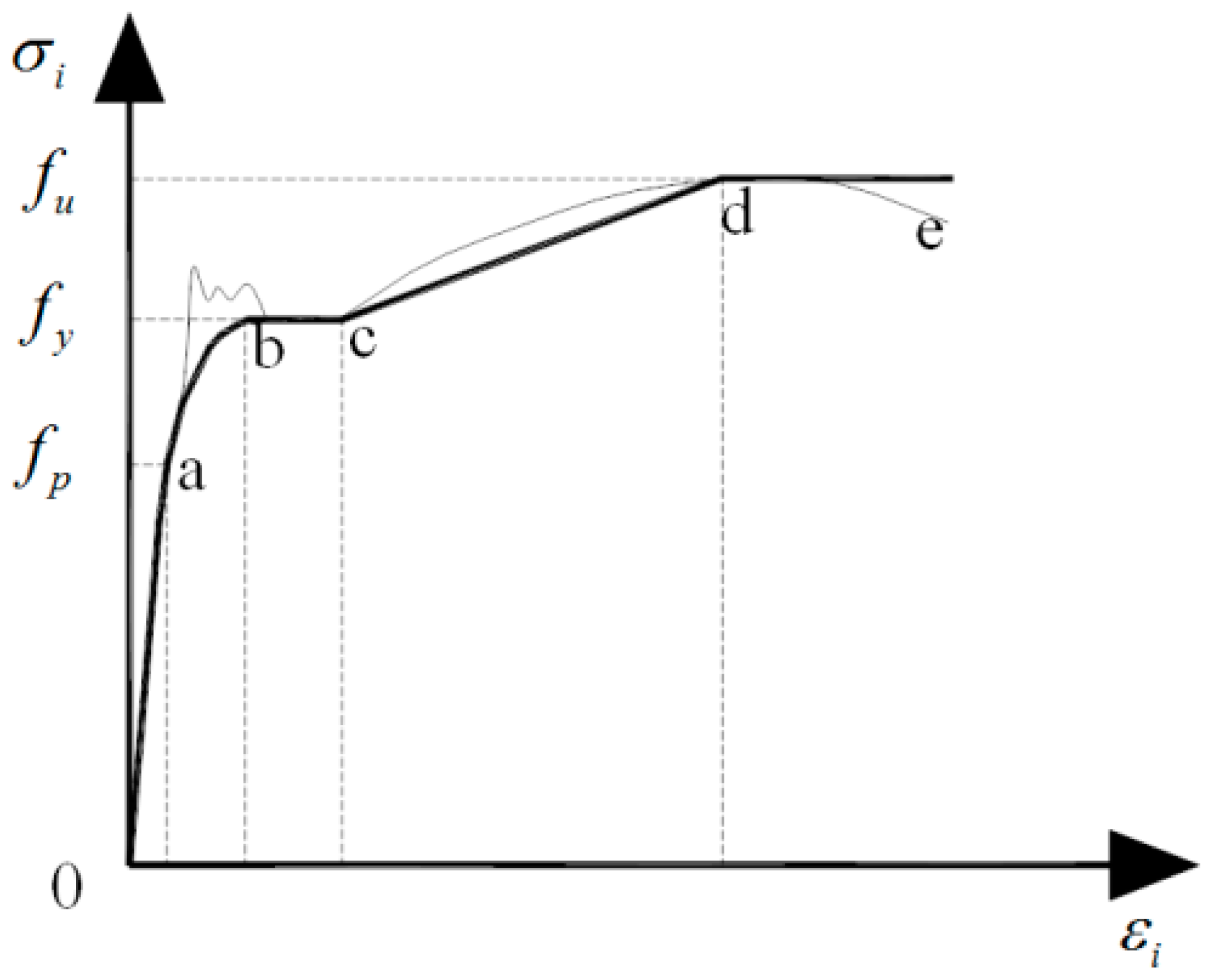
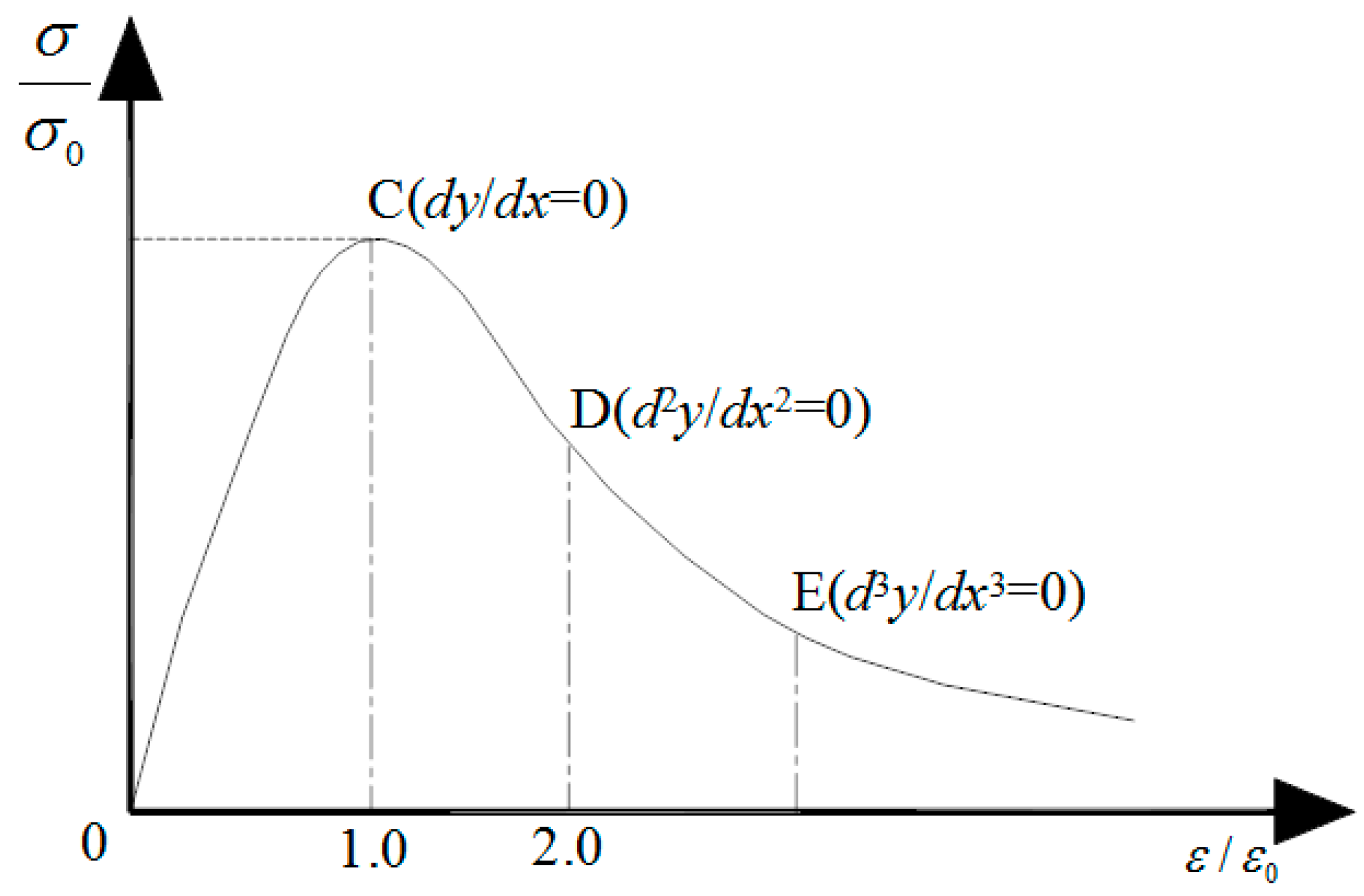

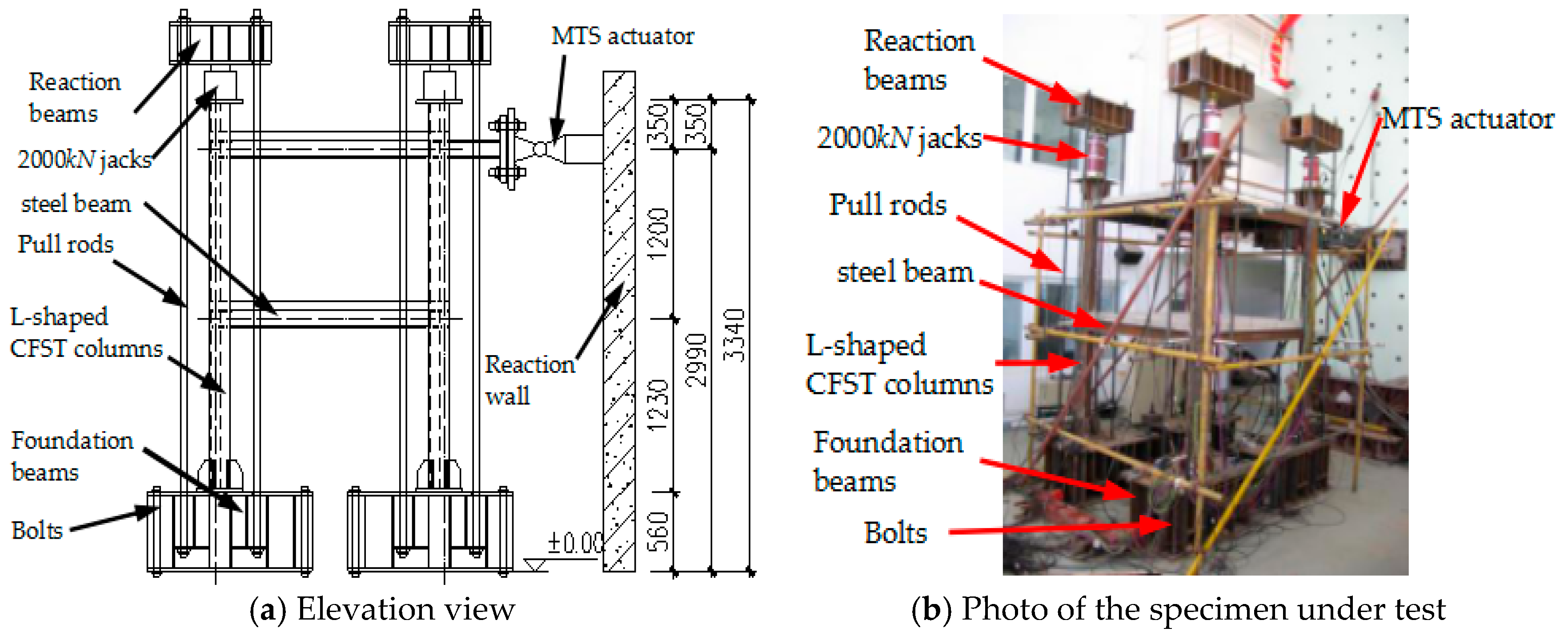
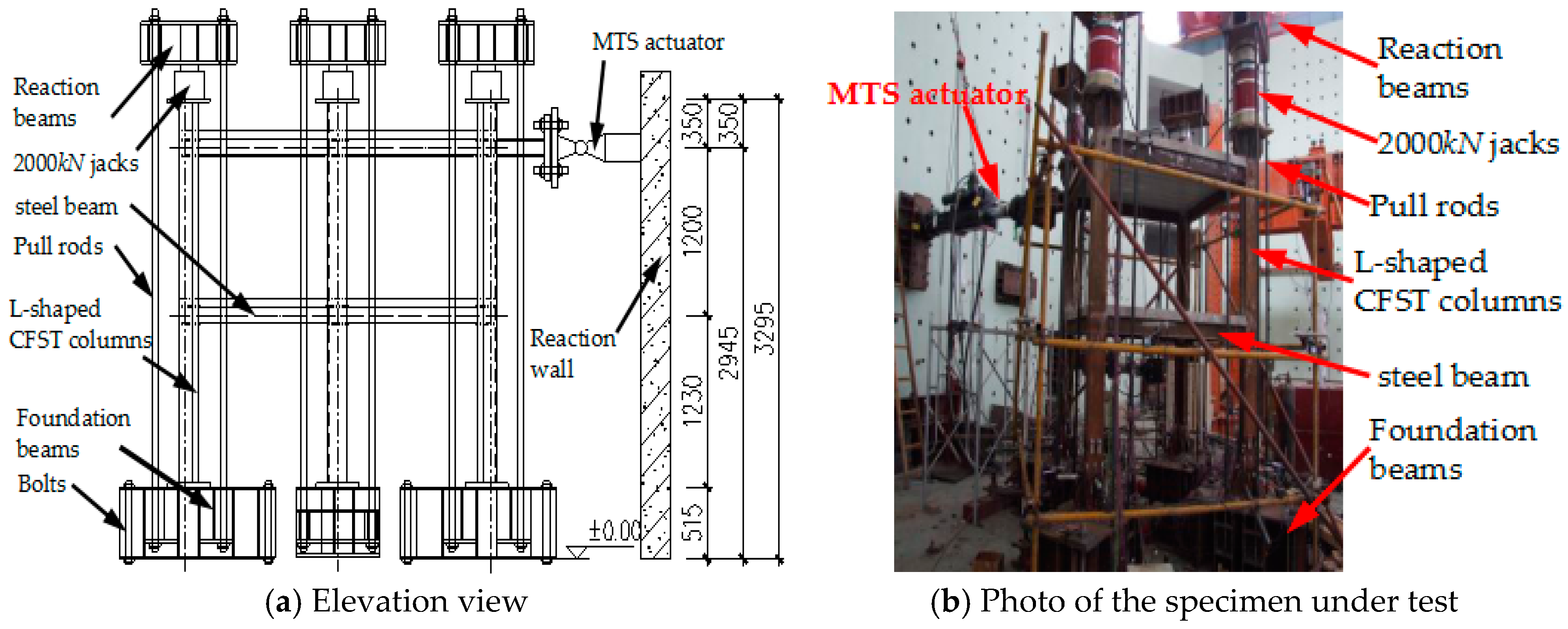

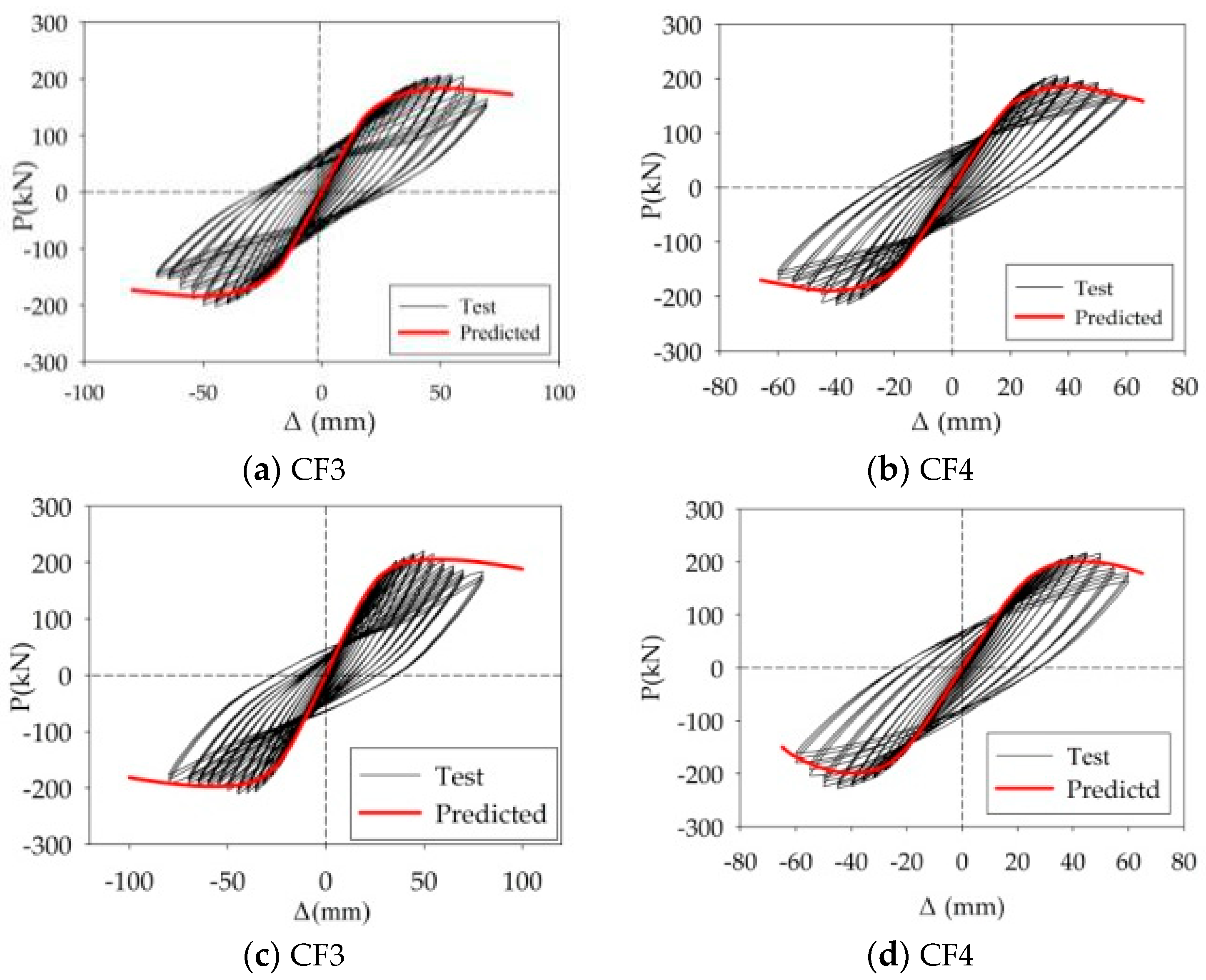


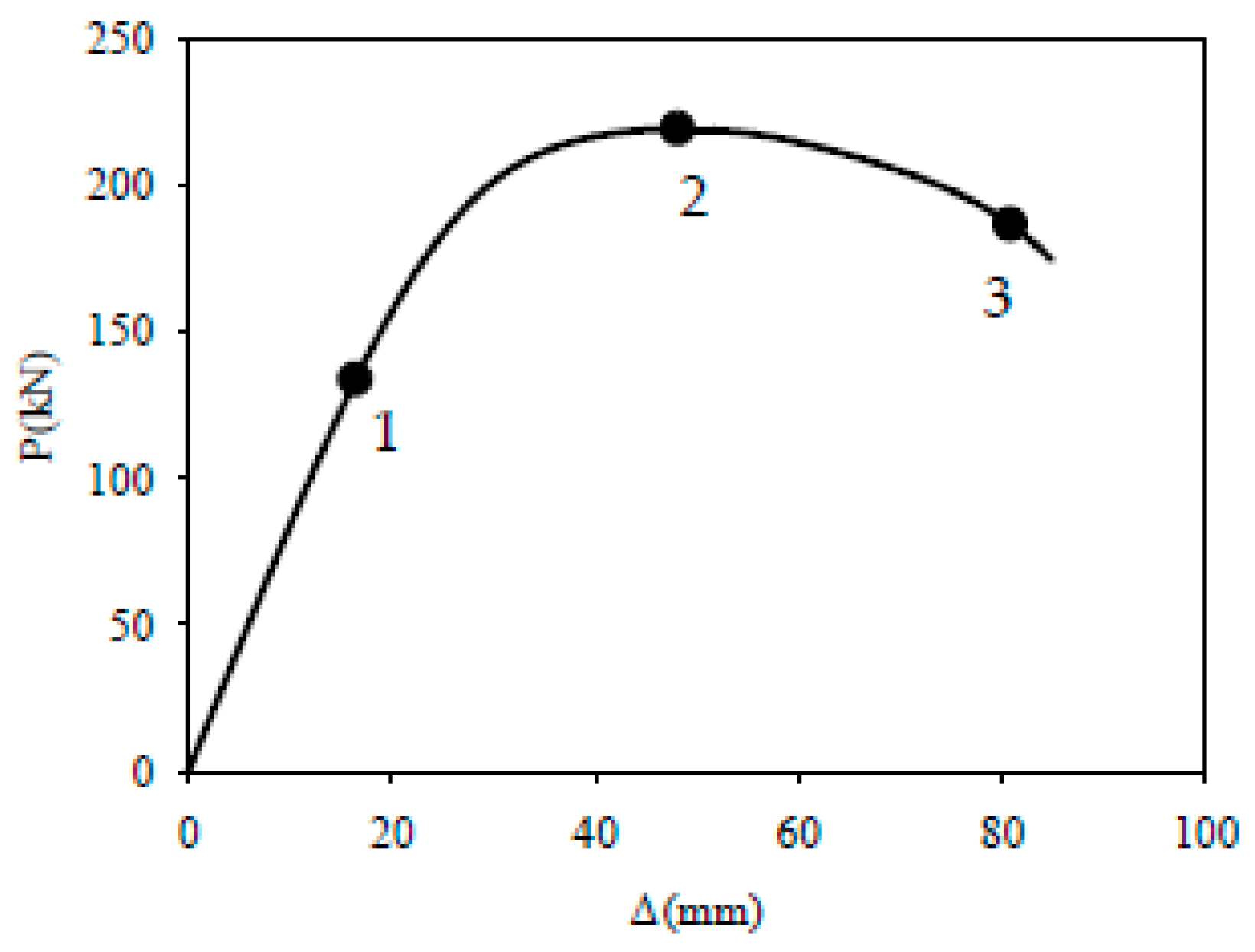
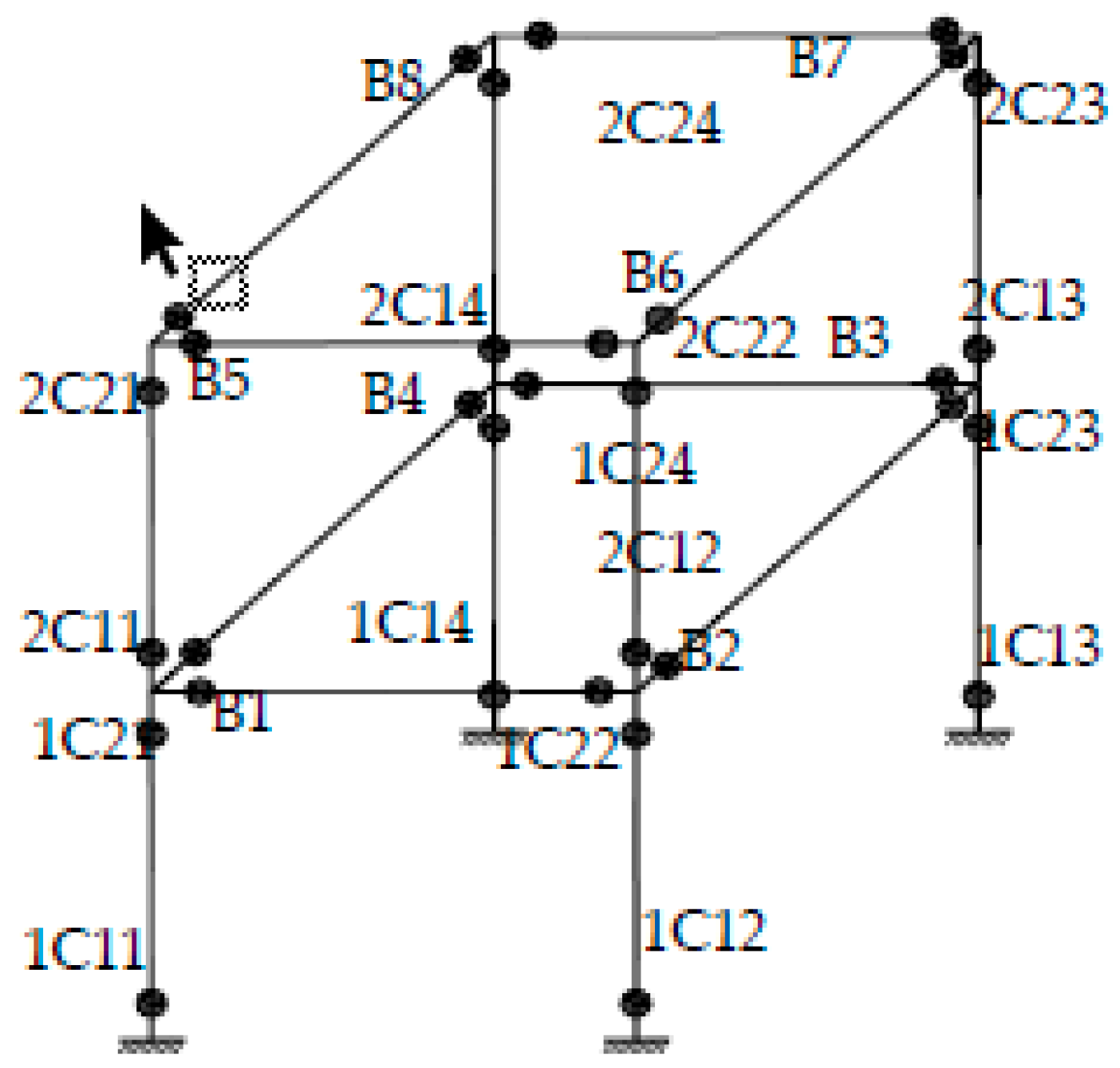








| CF | D (mm) | B (mm) | T (mm) | C | n | N |
|---|---|---|---|---|---|---|
| CF1 | 160 | 80 | 4 | C40 | 00 | 0.4 |
| CF2 | 160 | 80 | 4 | C40 | 00 | 0.6 |
| CF3 | 160 | 80 | 4 | C40 | 450 | 0.4 |
| CF4 | 160 | 80 | 4 | C40 | 450 | 0.6 |
| Steel Type | t (mm) | fy (MPa) | fu (MPa) | Es (MPa) |
|---|---|---|---|---|
| Tubes | 3.64 | 355 | 472 | 1.82 |
| Beam | 3.75 | 362 | 485 | 1.79 |
| Total Horizontal Displacement, x (mm) | x ≤ 10 | 10 ˂ x ≤ 20 | 20 ˂ x |
|---|---|---|---|
| Each stage displacement increments (mm) | 2 | 2 | 5 |
| Number of cycles | 1 | 3 | 3 |
| CF | Standard Deviation | Coefficient of Variation | |||
|---|---|---|---|---|---|
| CF1 | 188.7 | 207.5 | 0.909 | 0.014 | 1.5% |
| CF2 | 185.8 | 206.1 | 0.902 | ||
| CF3 | 205.4 | 220.7 | 0.931 | ||
| CF4 | 200.9 | 216.7 | 0.927 |
© 2018 by the authors. Licensee MDPI, Basel, Switzerland. This article is an open access article distributed under the terms and conditions of the Creative Commons Attribution (CC BY) license (http://creativecommons.org/licenses/by/4.0/).
Share and Cite
Zhang, J.; Li, Y.; Zheng, Y.; Wang, Z. Seismic Damage Investigation of Spatial Frames with Steel Beams Connected to L-Shaped Concrete-Filled Steel Tubular (CFST) Columns. Appl. Sci. 2018, 8, 1713. https://doi.org/10.3390/app8101713
Zhang J, Li Y, Zheng Y, Wang Z. Seismic Damage Investigation of Spatial Frames with Steel Beams Connected to L-Shaped Concrete-Filled Steel Tubular (CFST) Columns. Applied Sciences. 2018; 8(10):1713. https://doi.org/10.3390/app8101713
Chicago/Turabian StyleZhang, Jicheng, Yong Li, Yu Zheng, and Zhijie Wang. 2018. "Seismic Damage Investigation of Spatial Frames with Steel Beams Connected to L-Shaped Concrete-Filled Steel Tubular (CFST) Columns" Applied Sciences 8, no. 10: 1713. https://doi.org/10.3390/app8101713





